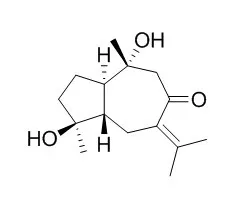| Description: |
Zedoarondiol has anti-inflammatory activity, inhibits iNOS, COX-2, and pro-inflammatory cytokine expressions by suppressing the phosphorylations of IKK and MAPKs, and by subsequently inactivating the NF-kappaB pathway. It dose-dependently inhibits LPS-stimulated nitric oxide (NO), prostaglandin E(2) (PGE(2)), tumor necrosis factor-alpha (TNF-alpha), interleukin-6 (IL-6), and interleukin-1beta (IL-1beta) productions in RAW 264.7 macrophage and in mouse peritoneal macrophage cells. |
| In vitro: |
| Int Immunopharmacol. 2009 Aug;9(9):1049-57. | | Zedoarondiol isolated from the rhizoma of Curcuma heyneana is involved in the inhibition of iNOS, COX-2 and pro-inflammatory cytokines via the downregulation of NF-kappaB pathway in LPS-stimulated murine macrophages.[Pubmed: 19398040 ] |
Several sesquiterpene lactones that have been isolated from medicinal plants are known to have many pharmacological activities.
METHODS AND RESULTS:
In this study, we investigated the anti-inflammatory effects of Zedoarondiol, a sesquiterpene lactone isolated from the rhizoma of Curcuma heyneana, in lipopolysaccharide (LPS)-stimulated macrophage cells. Zedoarondiol dose-dependently inhibited LPS-stimulated nitric oxide (NO), prostaglandin E(2) (PGE(2)), tumor necrosis factor-alpha (TNF-alpha), interleukin-6 (IL-6), and interleukin-1beta (IL-1beta) productions in RAW 264.7 macrophage and in mouse peritoneal macrophage cells. Consistent with these findings, in RAW 264.7 cells, Zedoarondiol suppressed the LPS-stimulated protein levels of inducible nitric oxide synthase (iNOS) and cyclooxygenase-2 (COX-2) and the mRNA expressions of iNOS, COX-2, TNF-alpha, IL-6, and IL-1beta in a concentration-dependent manner. Moreover, molecular data revealed that Zedoarondiol inhibited LPS-stimulated DNA binding activity and the transcription activity of nuclear factor-kappa B (NF-kappaB), and this effect was accompanied by decreases in the degradation and phosphorylation of inhibitory kappaB (IkappaB)-alpha, and in the subsequent blocking of NF-kappaB translocations to the nucleus. Furthermore, Zedoarondiol attenuated the phosphorylations of IkappaB kinase (IKK), extracellular signal-regulated kinase (ERK), p38 mitogen-activated protein kinase (p38), and c-Jun N-terminal kinase (JNK) in LPS-stimulated RAW 264.7 cells.
CONCLUSIONS:
Taken together, the findings of the present study indicate that Zedoarondiol inhibits iNOS, COX-2, and pro-inflammatory cytokine expressions by suppressing the phosphorylations of IKK and MAPKs, and by subsequently inactivating the NF-kappaB pathway. These relations reveal, in part, the mechanism underlying the anti-inflammatory properties of Zedoarondiol. |
|






 Cell. 2018 Jan 11;172(1-2):249-261.e12. doi: 10.1016/j.cell.2017.12.019.IF=36.216(2019)
Cell. 2018 Jan 11;172(1-2):249-261.e12. doi: 10.1016/j.cell.2017.12.019.IF=36.216(2019) Cell Metab. 2020 Mar 3;31(3):534-548.e5. doi: 10.1016/j.cmet.2020.01.002.IF=22.415(2019)
Cell Metab. 2020 Mar 3;31(3):534-548.e5. doi: 10.1016/j.cmet.2020.01.002.IF=22.415(2019) Mol Cell. 2017 Nov 16;68(4):673-685.e6. doi: 10.1016/j.molcel.2017.10.022.IF=14.548(2019)
Mol Cell. 2017 Nov 16;68(4):673-685.e6. doi: 10.1016/j.molcel.2017.10.022.IF=14.548(2019)